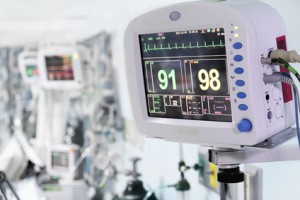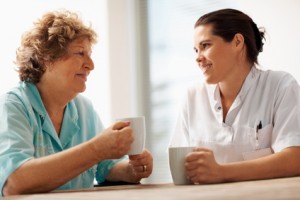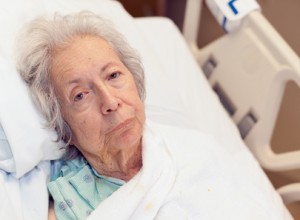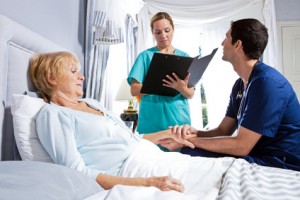Dr. Louis F. Janeira comes on the scene and tries to make sense of things. He eventually learns that a) the large man holding the small woman is named Jason, b) the small woman is his wife, Mary, who the doctor had in fact seen the day before due a slow heartbeat but didn’t recognize, upside-down.
Dr. Janeira discovered that the pacemaker was successfully installed the day before, and Mary had returned home from the hospital that morning. Everything was fine until about half an hour beforehand, when she had coughed and then collapsed.
Her husband Jason explained that she had fallen behind the bed and he’d picked her up by her ankles, and she regained consciousness. When he’d put her down, she fainted again. This process repeated a few times; she’d pass out, he’d pick her up by her ankles, and she’d be back again. So they’d given up on the experimenting and he was just carting her around by her ankles to keep her conscious.
An Urgent Diagnosis
My mind raced through the possibilities. Mary could have something obstructing the blood flow from her heart to her brain that was overcome when her head was down. Or her blood pressure could be so low that blood reached the brain only when she was upside down. Blood pressure that low could have been triggered by an allergic reaction, anaphylactic shock, or severe dehydration.
Another possibility was that Mary was suffering from cardiac tamponade, a compression of the heart caused by a buildup of blood in the sac covering the organ. If her heart had been perforated during the pacemaker implantation and blood had seeped out into the sac around it, it might be that her ventricles were now being squeezed by this accumulating blood, lowering her cardiac output. That condition could improve when she was upside down by increasing blood flow to the brain.
The first thing to do was to check Mary’s vital signs. “Bring her into a room,” I said. “Let’s get her on a monitor.”
I pointed the way, and Jason carried her into the cardiac room, an entourage of curious ER personnel trailing behind us.
Even once in the cardiac room, Jason was unconvinced that he should let go of her ankles and put her on the bed. “When I put her down, she’ll go out on us,” he said.
I paused for a moment. “We’ll do an assessment of the vital signs first while Mary is upside down. Then we’ll put her in bed and see if and how things change, OK?”
Jason nodded. Mary’s long black hair waved back and forth, which I took for agreement from her, too. Ellie then placed heart monitor electrodes on her chest.
“Normal-paced rhythm,” I said, watching the monitor. “The pacemaker is working perfectly fine right now.”
“And I feel perfectly fine,” said Mary. “Well, except that I’m upside down and have been for about 30 minutes now.”
Ellie wrapped a blood pressure cuff around her arm. “It’s 120 over 66,” said Ellie. “Pretty good.”
“OK, slowly get her on her back,” I said. Jason walked closer to the bed and Ellie and I eased Mary down onto it. The only sound came from the heart monitor: beep, beep, beep, steady at 60 times a minute. We all held our breath.
Then the cardiac monitor showed a sudden change. The alarm began screaming.
“Here I go,” said Mary. “It’s happeni…” Her words dissolved into nothingness.
“No heart rhythm,” Ellie called out. “Pacemaker failure.”
“Get me epinephrine,” I yelled. Also known as adrenaline, epinephrine is a hormone that can constrict blood vessels and get a stalled heart beating again.
“But we don’t have an iv in yet,” said Ellie.
“Out of my way,” said Jason, pushing us aside to get to Mary’s feet. “I told you this would happen.” The big man grabbed Mary’s ankles and pulled them up in the air. Moments after Mary was upside down again, the heart monitor resumed steadily beeping.
“I’m back,” said Mary.
Something must have gone wrong with her operation yesterday, I thought. Then suddenly it hit me. “The pacemaker lead, the wire going from the pacemaker generator to your right ventricle, must have disconnected. Your coughing spell could have done it,” I said. “Somehow, the lead reconnects when you are upside down and continues to stimulate the heart.”
Pacemakers are made up of two main components, a generator and a lead that carries electrical impulses to the heart. Often the lead tip is screwed directly into the heart muscle, but in rare cases it can dislodge and cease to stimulate the heart. Data from St. Jude Medical, one of the largest pacemaker manufacturers, show that out of about 220,000 implants of the company’s most popular lead attached directly to the heart, only 97 dislodged within 30 days of implantation. Apparently, Mary was one of the rare cases.
Getting The Patient Upright
“How are we going to fix this, doc?” Jason wanted to know.
“You’ll need to go back to surgery to reattach the lead,” I said to Mary. “Let’s page your electrophysiologist stat.” I looked at Jason and sighed. “Meanwhile, keep her upside down.”
We inserted an iv in Mary’s arm and hooked her up to an external pacing device. But pacing her heart through her chest wall gave her severe discomfort and was not a good option, even in the short term. Moreover, it turned out that Mary’s slow beat did not respond at all to medications, including intravenous epinephrine. So she was quickly transported to the electrophysiology laboratory, dangling by her ankles, carried by the only man around with enough strength to do it. And my ER shift continued.
The next day I was back on duty. As I came out of a room after examining a small child with a fever, I heard a familiar voice behind me.
“Dr. Janeira, it’s me, Mary. I’m all fixed up.”
I turned and smiled at Mary and nodded at Jason, who towered massively behind her. “You were right. The pacemaker’s ventricular lead had to be re-screwed in my heart,” she said. “I’ll be having the pacemaker checked in a few days and then every three months.”
“How do you feel now?” I asked.
“Back to normal,” she said. “Thanks for your help!”
And with that, she left my ER walking upright and hand-in-hand with her giant.










